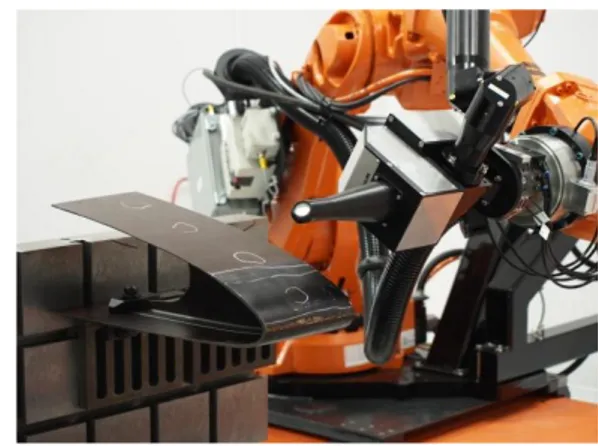THE 19TH INTERNATIONAL CONFERENCE ON COMPOSITE MATERIALS
1 Introduction
The composite aerospace industry grows continuously and the needs for reliable non-destructive testing (NDT) technologies and techniques are high. The Centre Technologique en Aérospatiale (CTA) is unique in its kind, for it gathers three major inspection methods in one place: shearography, thermography and laser-ultrasonics. In order to challenge and demonstrate their capacities, those three cutting-edge technologies were used to inspect aeronautic composite parts provided by the Centre Spatial de Liège (CSL). 2 Inspection techniques
2.1 Shearography
Shearography is an optical method, based on speckle interferometry, for the non-contact measurement of out-of-plane deformations of a material surface [1]. Shearography inspection of composite parts was performed using a Dantec technology. The apparatus uses a DANTEC camera with eight lasers of 120mW at a wavelength of 660nm and is monitored by ISTRA4D X 86 software. Thermal load can be applied by a heating lamp of 750W, monitored by the ISTRA software. This apparatus is mobile and can be fixed on an ABB robot.
2.2 Thermography
Pulsed thermography is one of the most popular thermal stimulation methods in active thermography [2]. One reason for this is the quickness of the inspection. Relying on a short thermal stimulation, the pulse duration goes from a few milliseconds for high conductivity materials (such as metal) to a few seconds for low conductivity ones (such as plastics). In addition, the brief heating sequences prevent damage to the component. While the part receives the pulsed thermal energy, the IR camera (3 – 5 m) records the temperature evolution for each pixel of
the 640 x 512 detectors from Telops. Many processing techniques are then available [3] in order to determine the nature and the exact location of the defect. Results obtained using principal component thermography (PCT) and pulsed phase thermography (PPT) are presented.
2.3 Laser-ultrasonics
Ever since its first proof of concept on aeronautic materials in 1998 [4], the laser-ultrasonics made a major step forward in automation. A Laser Ultrasonics inspection System (LUIS, Tecnar©) (Fig.1) has been robotised to create a complete NDT solution for aerospace complex geometry composite parts. It uses a pulsed 100 mJ CO2 generation laser with a pulsed 20 mJ YAG detection laser at a frequency of 100 Hz. The spot diameter is 3mm and can run at any defined user’s speed (in our case, a speed of 50 mm/s with a 2.5mm overlap).
Figure 1: Laser ultrasonics with leading edge sample 3 Inspected parts
Four main aeronautic types of geometry made of CRFP were inspected by thermography, shearography and the laser-ultrasonics. Each part presents a complex 3D shape (omega insertion, curvature, stiffener(s), etc.) with artificial defects
COMPARISON OF THREE NDT TECHNIQUES FOR THE
INSPECTION OF AERONAUTIC COMPOSITE STRUCTURES
R. Dubé
1*, L. Scheed
1, J. Lewandowski
1, L. Mouret
1, M.P. Georges
2,
1
Centre technologique en aérospatiale, St-Hubert, Canada,
2Centre Spatial de Liège, Angleur, Belgium
* Corresponding author (robin.dube@college-em.qc.ca)
included during manufacturing (voids, PTFE insertions, etc.).
3.1 Plate with an omega shape
A 12x12in carbon-epoxy plate with an omega-shape stiffener in the middle was analyzed. 42 defects were included through variable depths (voids and insertions).
3.2 Wing leading edge
A portion of a carbon-epoxy wing leading edge (19in long and 8in wide) with a U-shape and a stiffener in the inner side was analyzed. Ten included defects had to be localised through variable depths. The nature of the defects was unknown. 3.3 Section of a carter retaining ring
A section of a circular carbon-epoxy part with a 19in radius of curvature, 15in long and 6in wide was analyzed. A hundred defects (PTFE and steel insertions) were included at three different depths. 3.4 Panel with integrated stiffeners
A 51x39in panel with several stiffeners was analyzed. 32 defects were included through variable thicknesses (PTFE insertions of different sizes) (Fig.2).
Figure 2: Panel with included defects location
4 NDT parameters and results 4.1 Shearography
Our shearography device detected every defect located under the first plies of the CFRP parts. However, the results revealed that the detection strongly depends on the nature of the defect. Indeed, what is observed is the effect of the stiffness of the
inserted defect which influences the surface deformation generated by the heating lamp.
4.2 Thermography
Thermography allowed detection of the inserts that are not too deep in those high performance composite parts. Identification of the defect is more difficult: determination of the defect type and depth demands careful signal processing and analysis. Comparison of PCT and PPT techniques was performed successfully. The test results are comparable to those obtained by shearography. 4.3 Laser ultrasonics
Ultrasounds generated by laser impact were revealed as the most accurate and reliable technique. The integration of the LUIS probe to a robot gave unprecedented results on complex geometries. Figure 3 shows an example of results obtained with the LUIS.
Figure 3: Example of results obtained with LUIS (Top : C-scan, Bottom : B-scan along horizontal profile)
References
[1] Y.Y. Hung and al.; Review and comparison of
shearography and active thermography for nondestructive evaluation; Materials Science and Engineering R 64 (2009) 73–112
[2] Maldague, X. P. Theory and practice of infrared
technology for non-destructive testing, NY : John
Wiley & Sons, 2001.
[3] Ibarra-Castanedo, C., Bendada, A., Maldague,X.P.,
Infrared vision applications for non-destructive testing of materials , 5th Pan American Conference
for NDT, 2-6 October 2011, Cancun, Mexico
[4] J.-P. Monchalin, C. Néron, M. Choquet, D. Drolet,
M. Viens, Laser-ultrasonics inspection and
characterization of aeronautic materials, ECNDT

